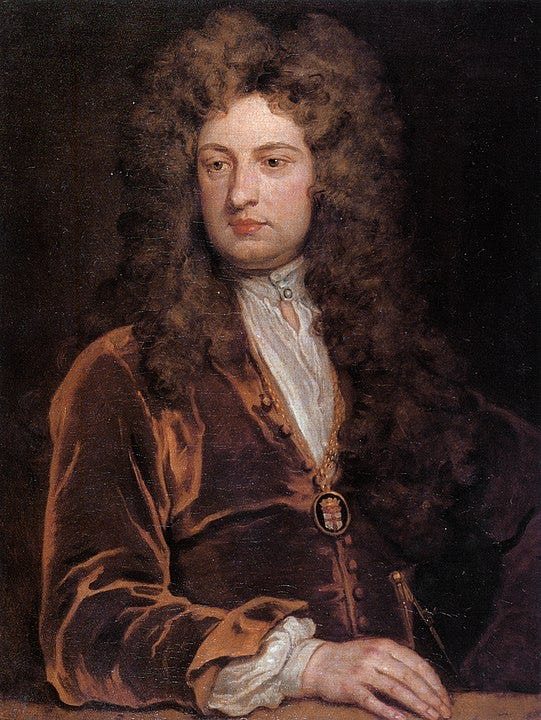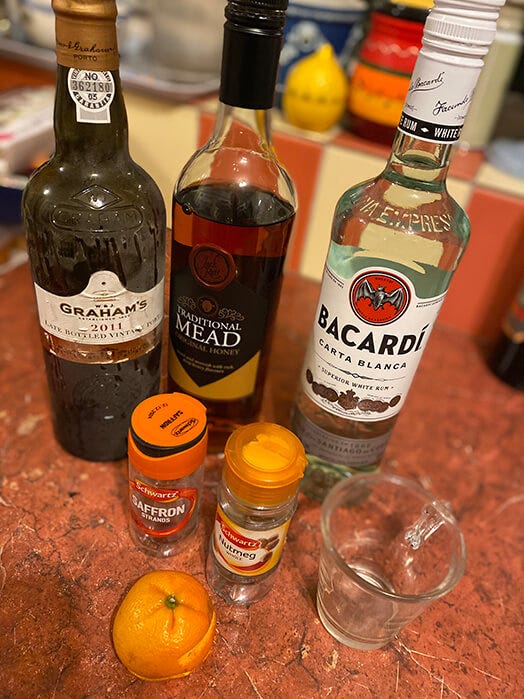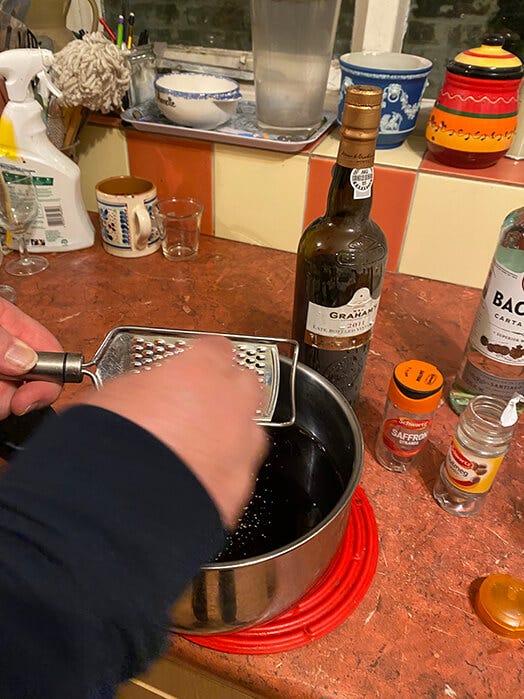
Last Christmas, while writing about Sir John Vanbrugh - playwright and architect of such buildings as Blenheim Palace - I read an excellent book by Ophelia Field about the Kit-Cat Club.1 Some will be familiar with this 18th-century club from Sir Godfrey Kneller’s portraits of its members (Vanbrugh’s is above). It was ostensibly a group of Whig arisocrats and writers who wanted to ensure a Hanoverian succession to the English throne after the death of Queen Anne. Meetings usually involved eating and boozing on the premises of pie-maker Christopher (Kit) Catling.
It’s in the context of these club meetings that Field mentions ‘Sir John Vanbrugh’s Cup’. Alexander Pope apparently told Joseph Spence about it, who recorded the recipe as follows:
… water or small beer; mead, port - two glasses each; rum, saffron - a very little of each; nutmeg, poker [i.e. warmed by inserting a hot poker], orange or lemon peel in winter; balm etc in summer.2
On the run-up to Christmas last year, I wondered if this drink could be recreated - how hard could it be? Admittedly, I had once tried to make a cream dessert from Hannah Glasse’s The Art of Cookery Made Plain and Easy (1747) and it was pretty challenging. In this case, the first problem was obtaining a bottle of mead (Glasse provides a recipe for mead, but I wasn’t that dedicated).3 We drove around all the supermarkets, farmers’ markets and delis and in the area, finally coming up trumps at Buzzards Valley, where we optimistically bought two bottles.
The other ingredients were not so difficult to obtain. We already had a bottle of port and our trusty Bacardi rum. According to my copy of Benjamin Franklin’s Book of Recipes, the word rum “either finds its orgins in the word ‘rumbullion’ (great tumult), or else it was named after ‘Ron Bacardi’, the original distiller of white Cuban rum”.4 I like to think that Vanbrugh chose it as an ingredient because he drank it in the Navy (rum from the British Virgin Islands was sold to the British Navy and given as a daily ration to sailors). But it was commonly used in punches too - along with brandy and Batavia arrack (an Indonesian drink distilled from rice).5
We opted for an orange-peel garnish, which would have been wholly appropriate for the Kit-Cats: all supporters of William of Orange.
While the ingredents were not too much trouble, the method was tricker than we thought. As Ophelia Field notes, Sir John Vanbrugh’s Cup is heated with a hot poker. I suppose this was quite a common practice in the 18th century, when people were cooking over open fires, but not so natural to us now. We opted instead for setting the brandy alight in a pan and pouring it into the mixture, much as you would with a Christmas pudding. A cop out? Perhaps, but we thought third-degree burns would not be a good start to the festive period.

We ended up with a strong beverage not unlike a sweet mulled wine (above). The mead, with its overtones of honey, was the most prominent flavour and the nutmeg and citrus gave it a distinctly Tudor feel. Nowadays we would expect to drink something like this in winter, but Vanbrugh’s recipe includes a garnish for summer. This did puzzle me; why would people want to drink something like this in hot weather? Was there a hot version for winter and a cold one for summer? (I’m assuming that “balm” means lemon balm, a herb which was said to make the heart “merry”).
There were so many questions. After I had sobered up I did some Googling and concluded that because we opted for flaming the alcohol in a pan we probably sacrificed quite a bit of flavour. The poker would have caramelised the sugars in the mead and provided a dark, smoky quality. It would surely have bubbled and burnt off some of the alcohol as well, resulting in a convivial drink rather than a ridiculously strong one. If you would like to see the poker method in action, I recommend watching this brilliant video. It not only heats the drink rapidly but also ignites the alcohol in the glass, melding all of the flavours together.

What did people in the 18th century expect when they ladled punch from a bowl into their cup? This is, in many ways, an unaswerable question. When you try to recreate an historical recipe there are practial issues - questions of method and changes in ingredients - but also problems of perception because, ultimately, our palates are not the same. As the authors of another favourite historical cookbook of mine put it:
… we know that it isn’t really possible to recreate the original, because too much in us has changed irretrievably. So, as with [playing 18th-century] music, we believe the intelligent solution is to seek a compromise: to try to work with an understanding of the way things were done two hundred years ago, but to take into account the fact that any performance always consists at least in part of its audience. In either case one must adapt to present-day conditions, at least to some degree, or lose a great deal of the message to be conveyed.6
Ophelia Field, The Kit-Cat Club (London: Harper Perennial, 2009).
Ibid., p. 124. For the original source, see Joseph Spence, Observations, Anecdotes, and Characters of Books, and Men, ed. James M. Osborn (Oxford, 1966), No. 484, quoting Alexander Pope in May 1730, Recipe for a jug of punch called ‘Sir John Vanbrugh’s Cup’.
1805 facsimilie of Hannah Glasse’s The Art of Cookery Made Plain and Easy (Bedford, Massachusetts: Applewood Books, 1997), p. 256.
Hilaire Dubourcq, Benjamin Franklin’s Book of Recipes (London: FlyFizzi Publishing, 2004), p. 82.
Basic punch was made from lemon, sugar, rum, brandy and boiling water.
Anne Chotzinoff Grossman and Lisa Grossman Thomas, Lobscouse & Spotted Dog: Which It’s a Gastronomic Companion to the Aubrey/Maturin Novels (New York and London: W. W. Norton & Company, 2000), p. xxii.








What a delightfully seasonal topic to tell us of Annette.
Here's another short video which you find interesting https://youtu.be/K4Cv1Sfn0HI
I have childhood memories of a cold poker being used to crack tough nuts such as Brazils and of a hot poker being used, experimentally but none too successfully, to find out what mulling wine (including barley wine) was, presumably as some passing craze, all about.
Happy New Year to you!
What an intriguing way of heating, with a hot poker! I wonder whether they relished too, that little bit of ‘theatre’, in the same way as some do with modern cocktails 🍷